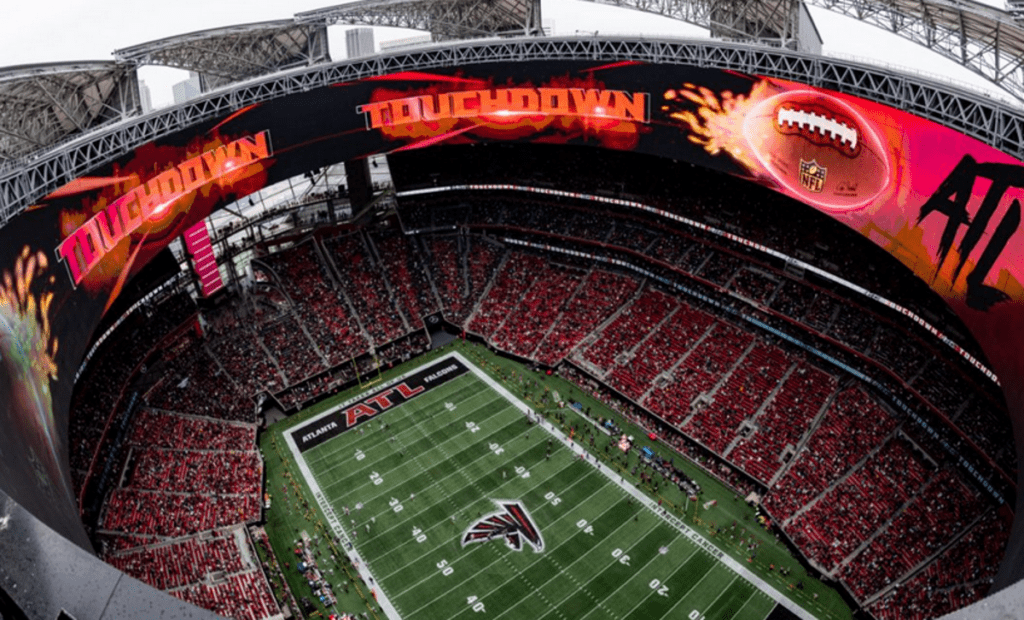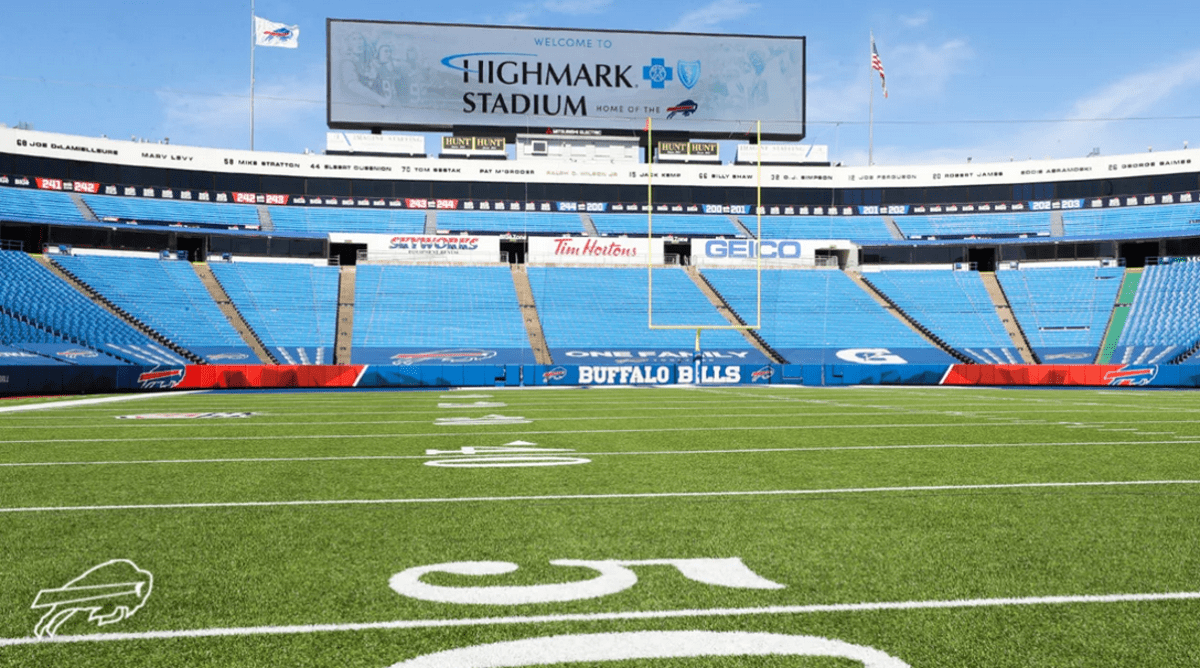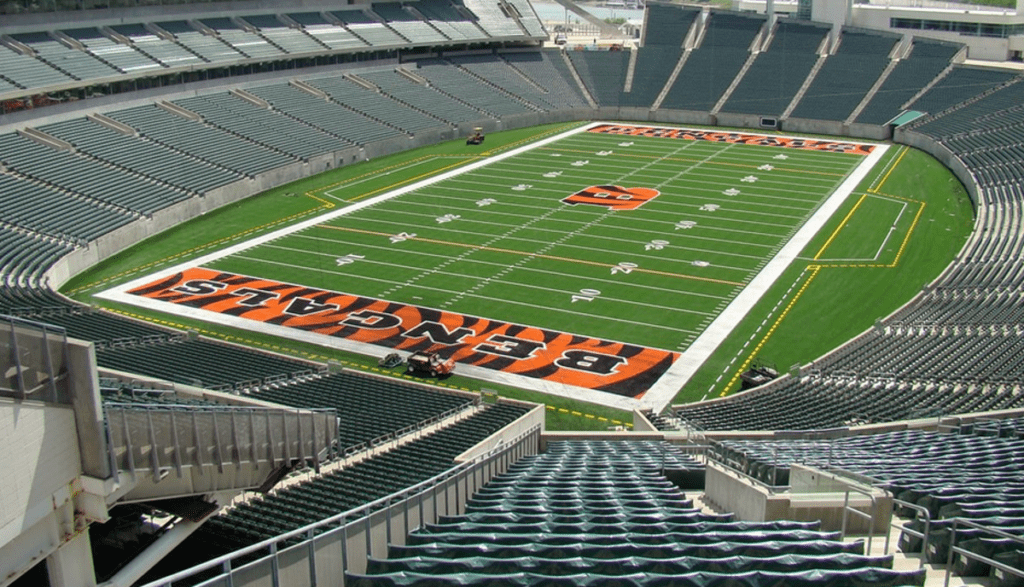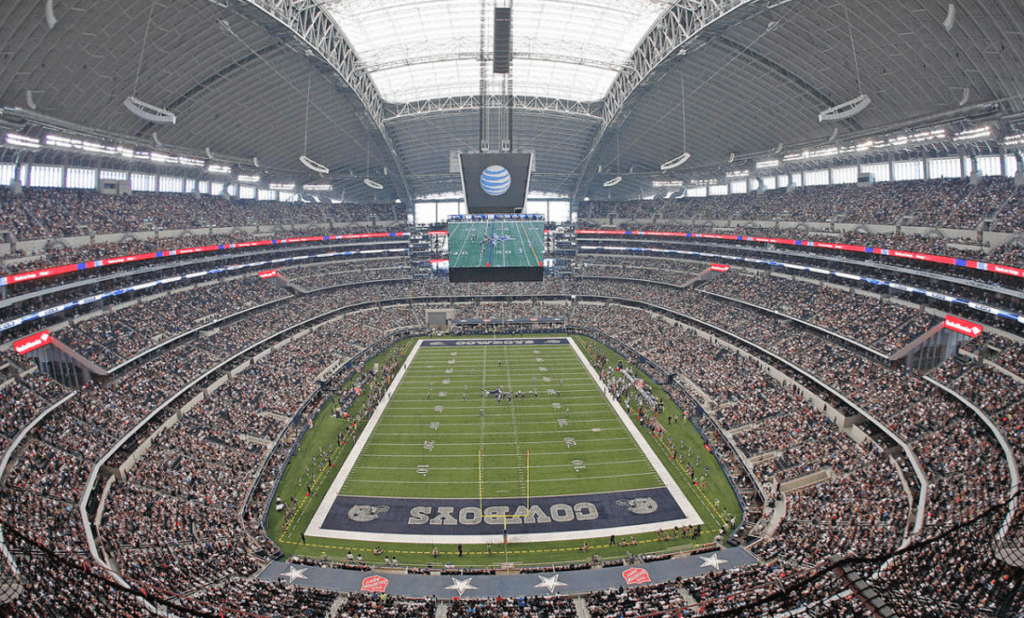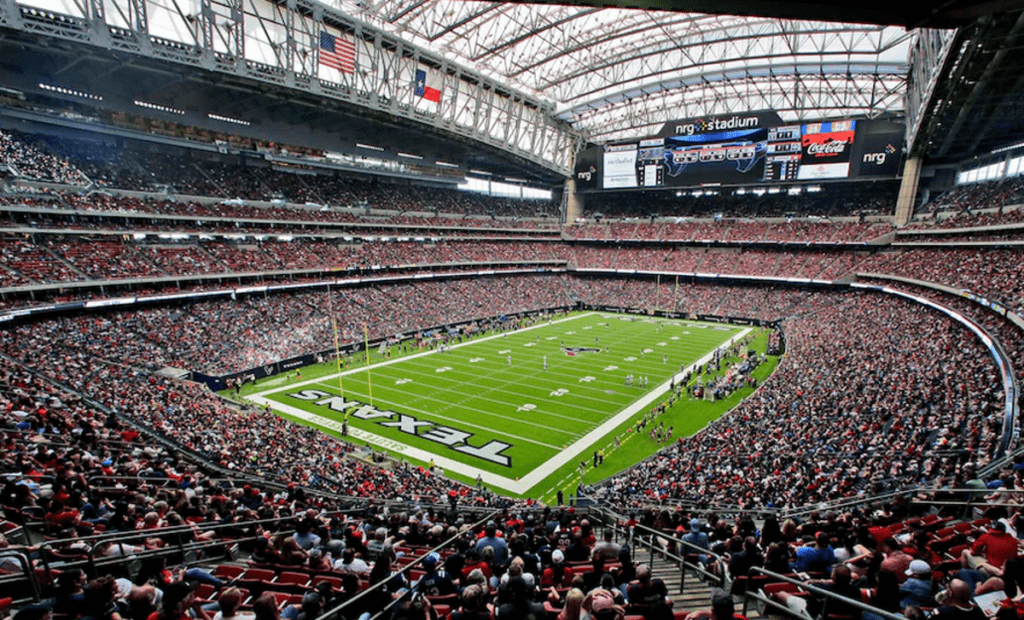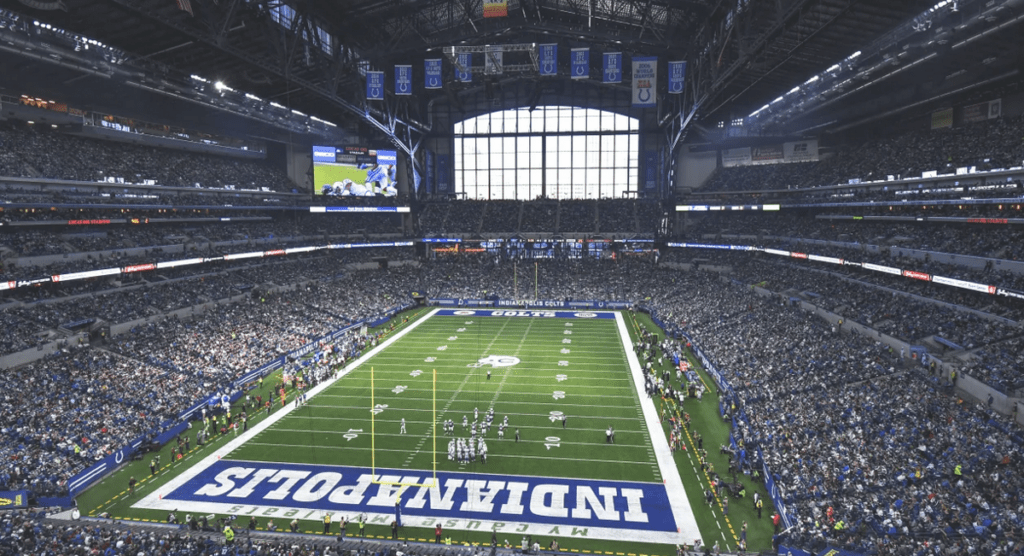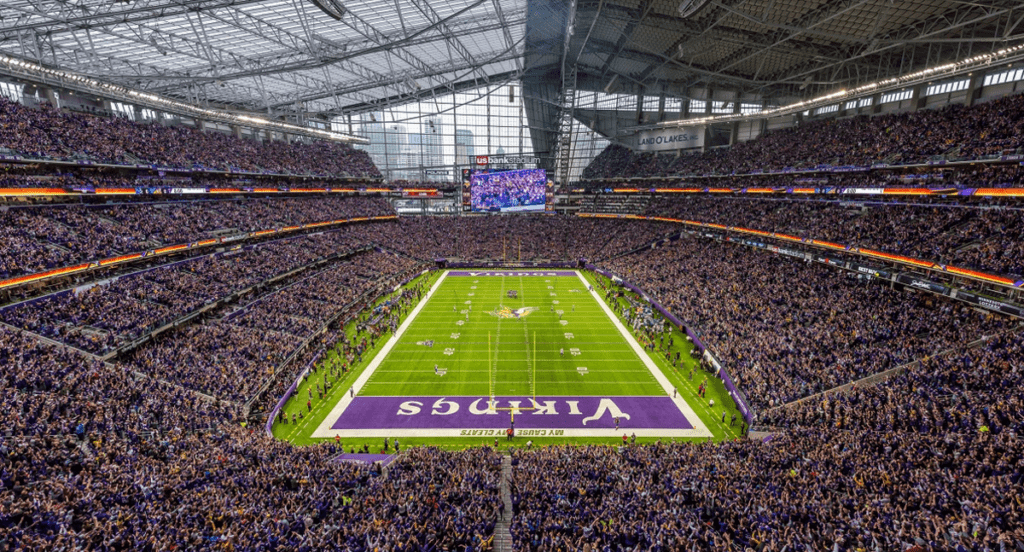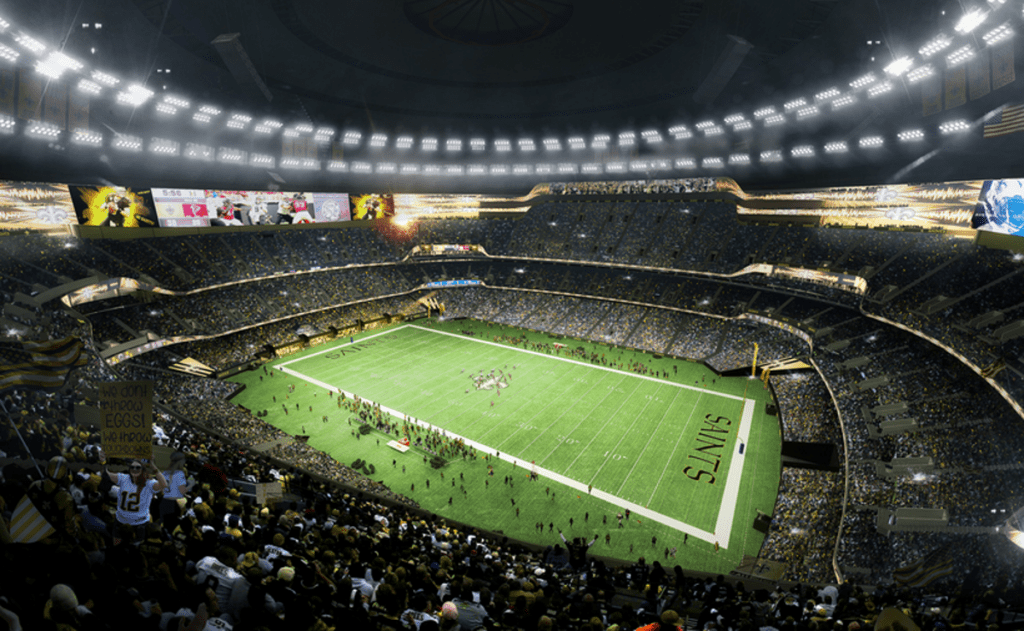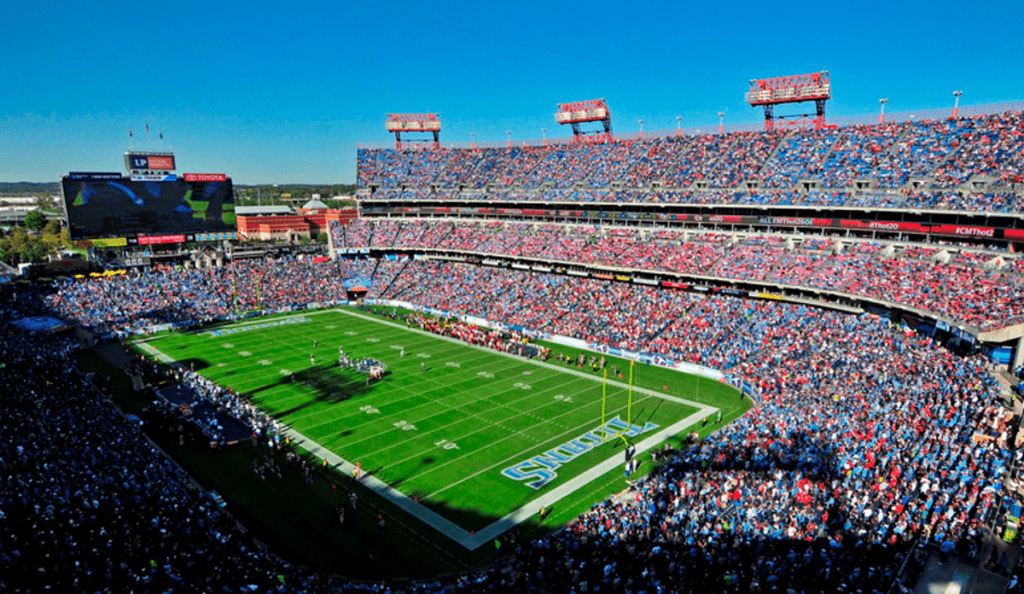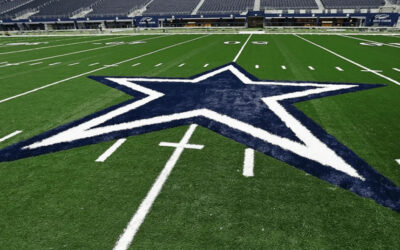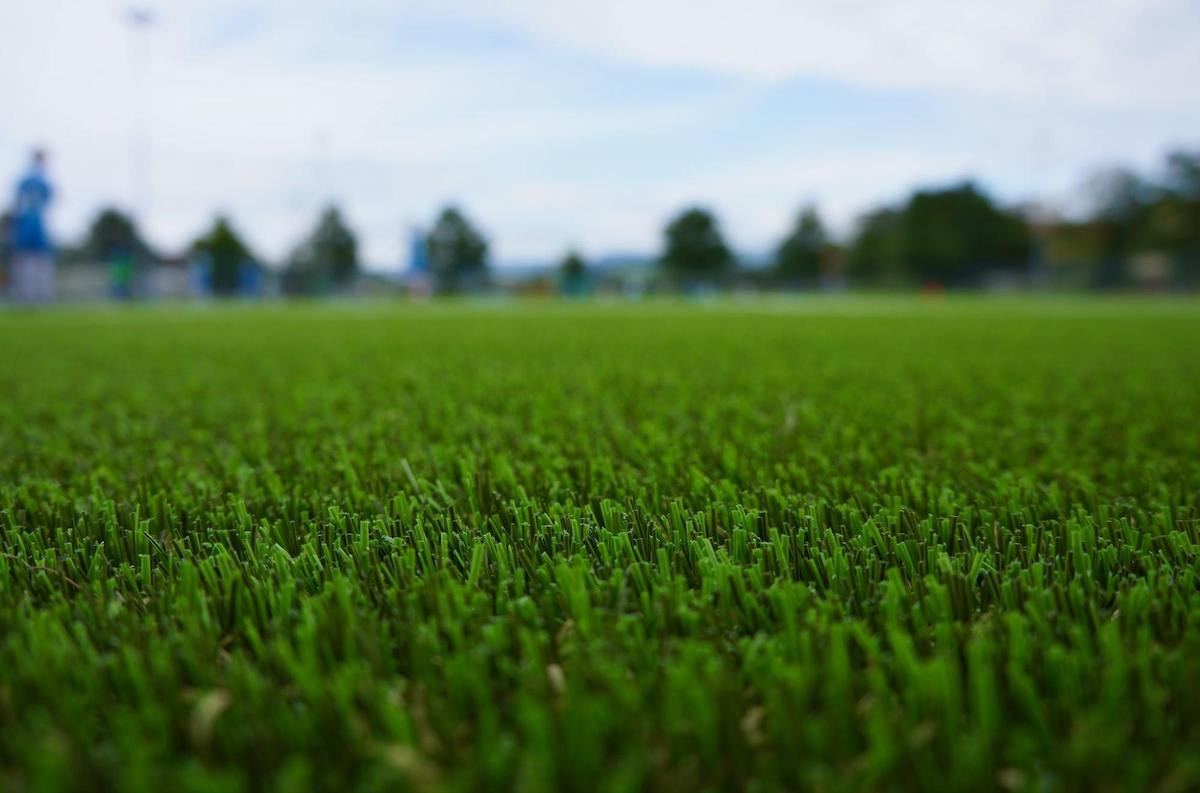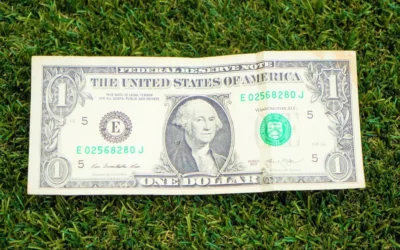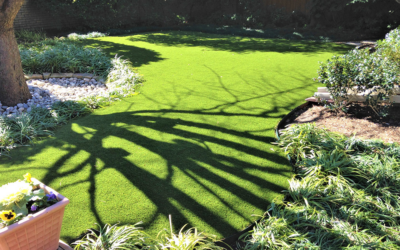Artificial turf or real grass?
It’s a huge choice for any NFL team to decide what surface they will play on. And while it’s currently a fairly even split between artificial turf and natural grass, the synthetic version just shades it in popularity.
The 32 NFL teams across the country use a total of 30 stadiums (the New York and Los Angeles teams share).
A total of 17 teams and 15 stadiums have installed artificial turf fields while 13 teams and stadiums use real grass fields and Just a couple opt for hybrid versions (which combine real grass with artificial grass).
Oh, and if you were wondering, both of the Texan NFL teams play on artificial grass!
Here’s a rundown of the 15 stadiums with synthetic turf installed …
What NFL stadiums have turf?
The following 15 NFL stadiums house 17 teams, all of which play their football on artificial turf fields:
Atlanta Falcons: Mercedes-Benz Stadium
The Mercedes Benz stadium is shared by the Atlanta Falcons NFL team and the Atlanta United soccer team and hosts plenty of events like live concerts too. With a capacity of 71,000, the stadium hosted the 2019 Super Bowl LIII and is also one of eleven U.S. stadiums set to host games in the 2026 FIFA World Cup.
Artificial turf was installed when the stadium opened in 2017 and a new installation was undertaken in 2019. The turf used here is constructed from monofilament fibers in Germany.
Buffalo Bills: Highmark Stadium
The Highmark Stadium, home of the Buffalo Bills in NY State has a capacity of over 71,000 and is used almost exclusively for professional football.
Artificial grass has been used here since the stadium opened in 1973. Astroturf was originally laid but was replaced in 2011 with a new turf, also manufactured in the U.S. It is composed of blended parallel-long slit film XP polyethylene fibers and premium monofilament polyethylene fibers. The Highmark is currently the only NFL stadium using this particular brand of turf though other venues use similar turf.
Carolina Panthers: Bank of America Stadium
The Bank of America Stadium uses the same type of artificial turf as several other stadiums, including the Atlanta Falcons and the New Orleans Saints. Made in Germany, this monofilament fiber-based polyethylene turf was installed as part of a $50-million facility renovation, completed in mid-2021.
The Carolina Panthers share the Bank of America stadium with Charlotte FC, the local soccer team, and has a capacity of almost 75,000.
Cincinnati Bengals: Paycor Stadium
The Cincinnati Bengals play at the Paycor Stadium, previously called the Paul Brown Stadium (it changed name in late 2022). The stadium has a capacity of just over 65,000 and regularly hosts college football too.
Artificial turf has been used in the stadium since 2004. The present incarnation was installed in 2018 and consists of 2.5 inches of slit-film fiber with a premier backing system. This turf is manufactured in Georgia and provides a lush and durable playing surface.
Dallas Cowboys: AT&T Stadium
The AT&T Stadium, home of the Dallas Cowboys, also hosts other premium events like the Cotton Bowl Classic, the Big 12 Championship Game and the Southwest Classic. The stadium has a capacity of 80,000 for football, making it one of the largest in the NFL and it is another of the U.S. venues scheduled to host matches during the 2026 FIFA World Cup.
Artificial turf was installed at the stadium in 2009 and has undergone several refits since. The current turf is manufactured in Austin, TX and is the same as the turf used at the home of the Houston Texans and the L.A. teams.
Detroit Lions: Ford Field
Ford Field is primarily home to the Detroit Lions and the Michigan Panthers (USFL). It also hosts other football games and events, such as basketball and wrestling and even hosted the 2006 Super Bowl XL
The stadium has a capacity of between 65,000 and 80,000 (the lower figure for NFL games). It has had artificial turf installed since its opening in 2002 and the present (third) incarnation is similar to the turf used for multiple other NFL stadiums and practice fields.
Houston Texans: NRG Stadium
With a capacity of almost 72,000, the NRG Stadium is another venue set to be used at the 2026 FIFA World Cup. It also hosted the 2017 Super Bowl LI (Houston has hosted three Super Bowls in total).
This open-air stadium has a retractable roof and is home to the Houston Texans as well as hosting exhibitions, concerts and other professional/amateur sporting events. Synthetic turf has been used at the NRG since 2015, shortly after the venue changed its name from the Reliant Stadium. The present turf is made in Austin, TX and is the same brand as that used at the AT&T Stadium.
Indianapolis Colts: Lucas Oil Stadium
The Lucas Oil Stadium is the home of the Indianapolis Colts and is also used for men’s and women’s tournaments in the NCAA.
The stadium has a capacity of 67,000 and hosted the 2012 Super Bowl XLVI. Artificial turf has been used here since its opening in 2008. The present turf is made in Georgia and employs slit-film technology with an optimized face weight for durability and performance. This was due to be replaced in 2024.
Los Angeles Chargers/Los Angeles Rams: SoFi Stadium
The SoFi Stadium is home to both of L.A.’s NFL teams, the Chargers and the Rams, as well as hosting the annual LA Bowl in college football. With a capacity of 70,000, this fixed-roof stadium is another of the venues earmarked to host World Cup games in 2026 and it hosted the 2022 Super Bowl LVI.
Artificial turf was installed at the SoFi when it opened in 2020 and the type chosen is similar to that employed at the home of the Dallas Cowboys and the Houston Texans.
Minnesota Vikings: U.S. Bank Stadium
Home to the Minnesota Vikings and the Minnesota Golden Gophers baseball, the U.S. Bank Stadium has a capacity of 66,200 and hosted the 2018 Super Bowl LII.
The stadium has had artificial turf since 2016 and employs turf made in Georgia — similar to the turf types used at Caesars Superdome, MetLife Stadium and Paycor Stadium.
New England Patriots: Gillette Stadium
The Gillette Stadium has a capacity of 65,878 and, despite being one of the smaller stadiums in the NFL, it is one of the venues chosen for the 2026 FIFA World Cup.
Home to the New England Patriots, artificial grass was installed at the stadium in 2006 and has remained ever since. The present synthetic turf was installed in 2017 and is of a similar type to that used on multiple game and training fields across the NFL.
New Orleans Saints: Caesars Superdome
Caesars Superdome in New Orleans is home to the Saints NFL team but is used for a lot more besides. As well as conventions, concerts, the annual Sugar Bowl and College Football Playoff games and NCAA Men’s Basketball, it has hosted seven Super Bowls and will host the 2025 Super Bowl LIX. The capacity is 74,295.
Artificial turf has been used since the Superdome first opened in 1975 — initially employing AstroTurf before replacing it in 2003 with a higher-quality playing surface. There have been several surfaces since but the present version is made in Georgia.
New York Giants/New York Jets: MetLife Stadium
The MetLife Stadium is home to both of New York City’s NFL teams, the Giants and the Jets. With a capacity of 82,500, it is one of the largest stadiums in the NFL and will also host games in the 2026 World Cup.
In 2023, the stadium installed artificial grass based on a new multi-layer dial-polymer monofilament fiber rather than the slit-film turf that had been in place since the 2020 season.
Seattle Seahawks: Lumen Field
Lumen Field has a capacity of 68,740 and is home to the Seattle Seahawks. The stadium has had artificial grass installed as its playing surface since its opening in 2002. The current surface is similar to that used on multiple other NFL game and practice fields.
Because the stadium has been chosen as a 2026 FIFA World Cup venue, grass will need to be installed for that tournament but it remains to be seen whether this will be a temporary or permanent move.
Tennessee Titans: Nissan Stadium
The Nissan Stadium, with a capacity of 69,143, is home to the Tennessee Titans and the Tigers of Tennessee State University.
The stadium is the most recent “convert” to artificial turf in the NFL, with the Titans making the switch in the fall of 2023 largely because of their notoriously inconsistent natural grass playing surface. The new surface will be a monofilament-based turf (made in Austin, Texas) with organic infill offering a more consistent playing experience year-round.
NFL stadiums with real grass
The most popular grass used on sports fields is Bermuda grass or Kentucky bluegrass. The following 13 NFL teams/stadiums retain real grass playing fields:
- Arizona Cardinals: State Farm Stadium
- Baltimore Ravens: M&T Bank Stadium
- Chicago Bears: Soldier Field
- Cleveland Browns: FirstEnergy Stadium
- Denver Broncos: Empower Field at Mile High
- Jacksonville Jaguars: TIAA Bank Field
- Kansas City Chiefs: Arrowhead Stadium
- Las Vegas Raiders: Allegiant Stadium
- Washington Football Team: FedExField
- Pittsburgh Steelers: Heinz Field
- San Francisco 49ers: Levi’s Stadium
- Tampa Bay Buccaneers: Raymond James Stadium
- Miami Dolphins: Hard Rock Stadium
NFL fields with hybrid playing surfaces
The two NFL fields that use a hybrid solution (a mix of artificial fibers and natural grass) are:
- Green Bay Packers: Lambeau Field
- Philadelphia Eagles: Lincoln Financial Field
Desso Grassmaster (the hybrid surface used) was developed in 1993 by the Dutch company Desso Sports. You may hear it referred to as “reinforced turf” or “stabilized turf”.
Benefits of turf over grass for sports fields
The debates over which is the better playing surface, natural grass or artificial turf, rage on. However, some people’s impressions of artificial sports turf are still stuck in the 1970s with AstroTurf.
The original sports field turf, developed in the 1960s and introduced to the NFL in 1965, was soon adopted by numerous football stadiums.
But comparing 1970s turf installations with modern installations would be like comparing cars from the same eras. They are very different. Modern synthetic turf has addressed many of its shortcomings in terms of appearance, safety, affordability and performance.
The latest commercial-quality artificial turf offers numerous benefits over natural grass for sports fields across the U.S., including:
- Low maintenance — artificial turf needs far less work to remain looking and performing at peak.
- Strength, resilience and durability — it’s tough enough to handle pro football games.
- Weatherproof qualities — whether it’s extreme heat, snow or rain, artificial turf stands up well to the elements allowing year-round play.
- No water required — compare this with grass fields, which guzzle water that is scarce in some central, southern and northwestern states.
- Affordability — according to estimates, natural grass fields at NFL venues can cost around $600,000 to $900,000 to install; when the high annual maintenance costs are also factored in, NFL stadiums can save money by installing artificial grass, which usually costs around $700,000.
Artificial turf for sports fields in Dallas-Fort Worth
Artificial grass is extensively used in professional and amateur sports across the U.S. Even teams that still use natural grass for their main stadiums often choose artificial turf for practice fields.
That’s because of the increasing availability of high-quality, safe, affordable synthetic turf.
If it’s good enough for the Dallas Cowboys and Houston Texans…think what high-quality commercial turf can do for your sports field or other commercial area. If you’re in the Dallas-Fort Worth area and are considering artificial turf for football, soccer or any other indoor or outdoor sport, speak with one of our artificial grass professionals to check your options.

